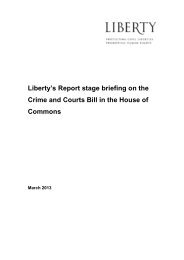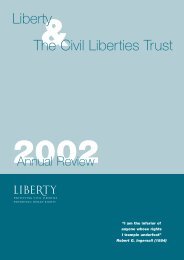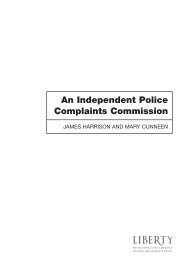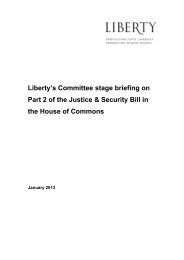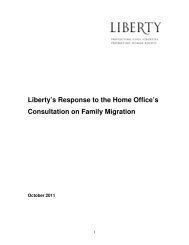Overlooked - Liberty
Overlooked - Liberty
Overlooked - Liberty
You also want an ePaper? Increase the reach of your titles
YUMPU automatically turns print PDFs into web optimized ePapers that Google loves.
116 <strong>Overlooked</strong>: Surveillance and personal privacy in modern Britain<br />
common law. The benefit of legislation is that it can remove uncertainty. New legislation could also<br />
do much to ensure a robust framework and proper accountability. The data protection principles in<br />
the DPA provide general guidance over the holding of data but do not cater for specificity over such<br />
important issues as the location and marking of cameras, arrangements for access to and<br />
destruction of footage, penalties for abuse and so on. What guidance there has been covering these<br />
issues has been published by a range of agencies. However, it has been essentially voluntary,<br />
unenforceable and dependant on the good will and good intentions of system operators 221 .<br />
There have, therefore, been two central concerns over CCTV regulation. First, there has been<br />
uncertainty of the application of the DPA to smaller systems arising from the decision in Durant.<br />
Secondly, even those systems that are covered by the DPA have only unenforceable guidance<br />
providing any detail on the specific application of the DPA to CCTV.<br />
A new DPA could formalise the principle that only the most basic domestic systems are not covered<br />
by the DPA. Perhaps more importantly it would allow effective and enforceable regulation. The<br />
Guidance provided by the ICO already provides the type of template that could easily be adopted. The<br />
purpose of guidance is to ensure that the practice complies with the relevant data protection principles.<br />
However, it also effectively fleshes out the appropriate practice in a manner that would be relatively<br />
easy to apply in statute either directly onto the face of a Bill or through accompanying regulation.<br />
A good example of this is contained in the ICO’s current code of practice when dealing with<br />
notification of CCTV system operation. The guidance states:<br />
“Signs should be placed so the public are aware they are entering a zone which is covered by<br />
surveillance equipments.<br />
The signs should be clearly visible and legible to members of the public<br />
The size of signs will vary according to circumstances:<br />
For example – a sign on the entrance door to a building society office may only need to be A4 size<br />
because it is at eye level of those entering the premises.<br />
For example – signs at the entrances of car parks alerting drivers to the fact that the car park is<br />
covered by such equipment will usually need to be large, for example, probably A3 size as they are<br />
likely to be viewed from further away, for example by a driver sitting in a car.<br />
The signs should contain the following information:<br />
a) Identity of the person or organisation responsible for the scheme.<br />
b) The purposes of the scheme.<br />
c) Details of whom to contact regarding the scheme.<br />
In exceptional and limited cases, if it is assessed that the use of signs would not be appropriate, the<br />
user of the scheme must ensure that they have:<br />
a) Identified specific criminal activity.<br />
b) Identified the need to use surveillance to obtain evidence of that criminal activity.<br />
c) Assessed whether the use of signs would prejudice success in obtaining such evidence.<br />
221<br />
See for example the guidance issued by the Information Commissioner’s Office in 2000 for operators of<br />
CCTV systems http://www.ico.gov.uk/upload/documents/library/data_protection/detailed_specialist<br />
_guides/cctv_code_of_practice.pdf and “A Watching Brief – A Code of Practice for CCTV” aimed at public<br />
sector users of systems published by the Local Government Information Unit in 1996.






